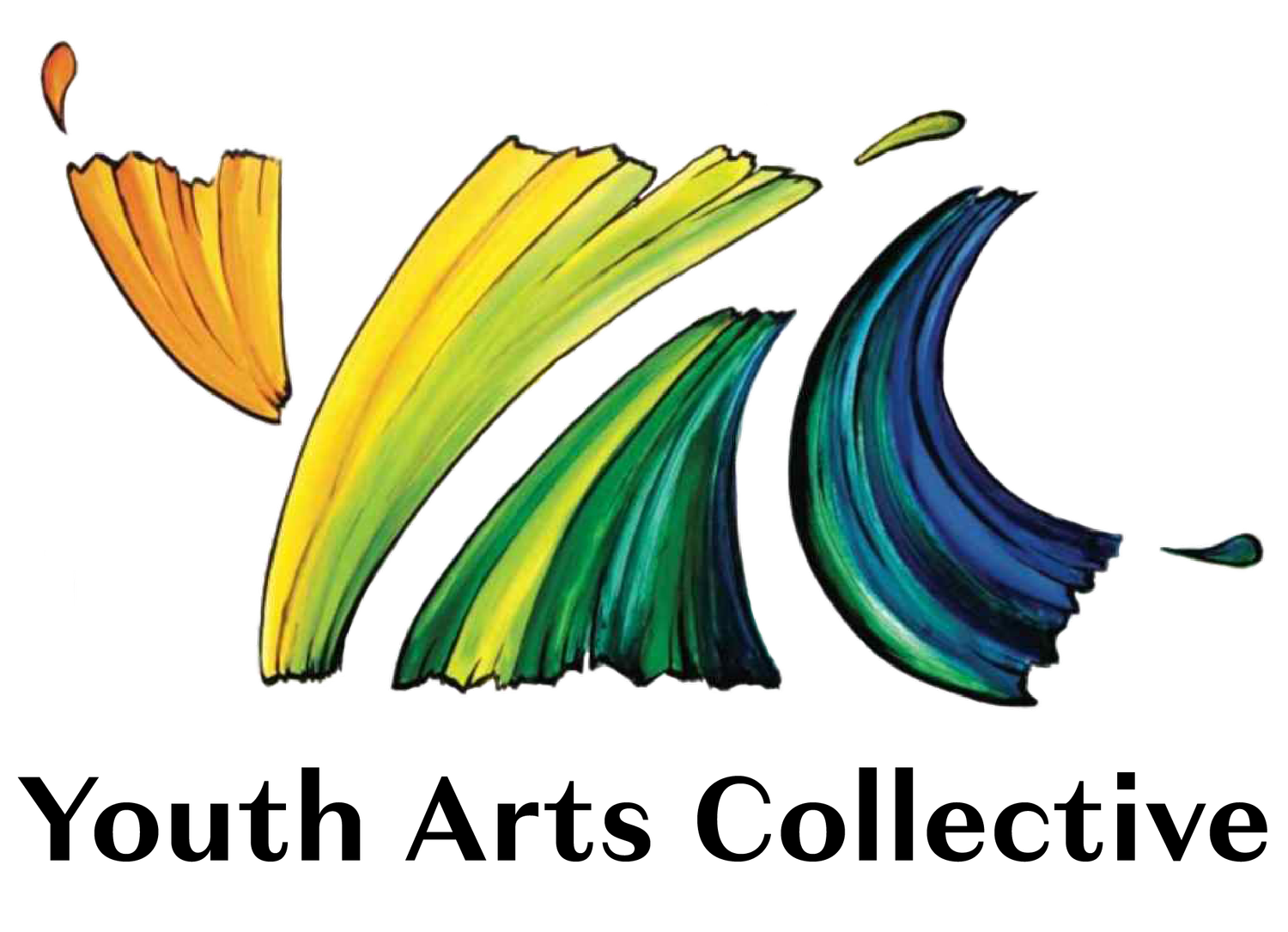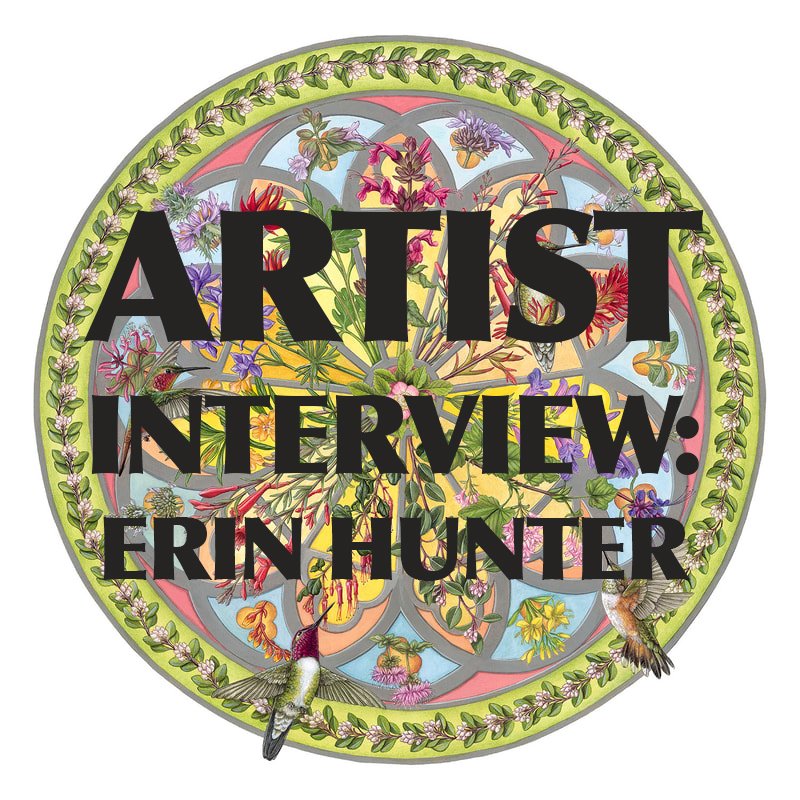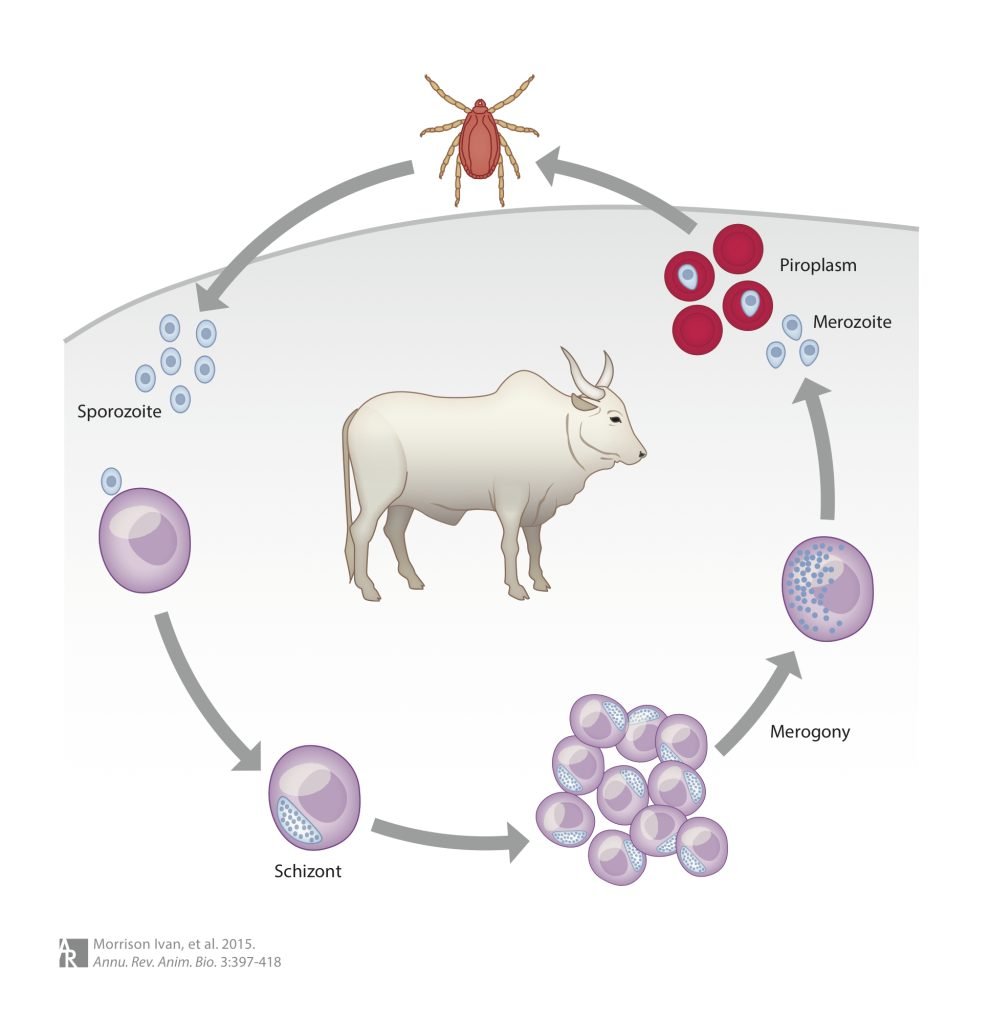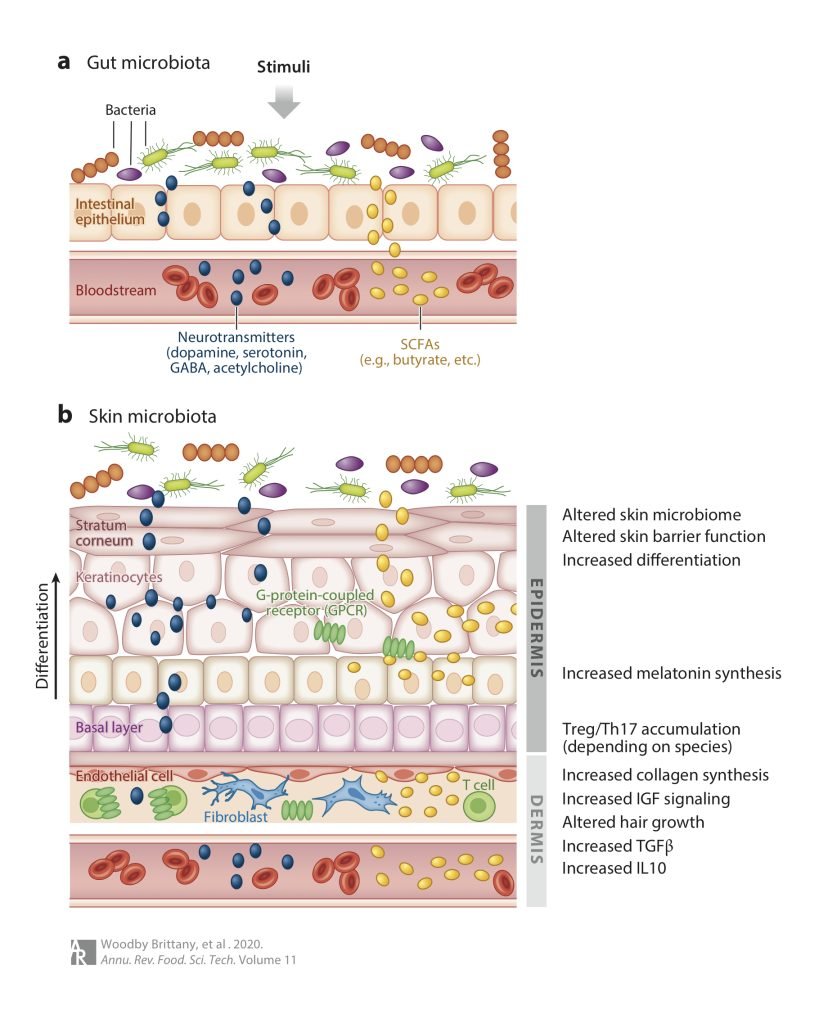Artist Interview: Erin Hunter
Artist Interview: Erin Hunter, text on top of nature mandala made of flowers and hummingbirds
We're so happy to introduce our newest artist interview with the wonderful Erin Hunter! Erin is a fantastically talented scientific illustrator and fine artist, and we were lucky enough to have her lead a nature sketching workshop at YAC last year! Find more of her work online at eehunter.com or on instagram @erinhunterart!
Tell us about the subject matter/content of your work.
As a kid, I was always really interested in the natural world, especially flowering plants, insects, and birds. And like many kids who grow up to be visual artists, I was constantly drawing, often getting in trouble at school for daydreaming and drawing when I should have been paying attention. Now I’m a science illustrator, and while that term encompasses a lot of different things that I do (fine art painting, technical illustrations for an academic publisher, children’s books, teaching), the common theme running through all of it is a fascination and close observation of the natural world. In my day-to-day work as an illustrator for Annual Reviews, I work on really technical stuff, which I find super interesting—things like how agriculture affects ground-nesting bees, or how the microbiome of the human gut is affected by diet. With my personal work, I focus on plant-pollinator interactions, which is a subject I’ve been obsessed with for years. I’m absolutely in love with flowering plants, bees, hummingbirds, all that stuff—I could go on for days about it!
Artist Erin Hunter, lying on the floor surrounded by a halo of plants, foliage, and flowers, with her illustrations in the center behind her head. Photograph by Amber Renee Maharjan.
Tell us about how you work/your process.
With my personal work, I’ll learn about something and become a little obsessed with it—I’ve been really interested in plant pollination for a long time now, but I’ll hear about something that piques my interest, like how certain plants and insects are totally dependent on each other (yucca moths and yucca flowers, for example). I’ll go down a very nerdy rabbit hole of research and if I think it would be a good candidate for a painting, I’ll start doing sketches on tracing paper. Sometimes I’ll email scientists and ask for advice or for permission to use their photos as reference images. Once I’ve got some sketches, I’ll scan them into Photoshop and play around with layout until I’m happy. Then I’ll print it out or have a copy shop print it out, then use carbon transfer paper to transfer the image to watercolor paper. I’ll block in the color with thin, watery washes of acrylic, then add detail. Throughout this entire process, I’m usually texting with a couple of friends from grad school who are also illustrators, sending them images and getting their feedback on layout, color, etc.
With my technical work, I’ll receive an article from my editor that has existing illustrations in varying stages of completion. Sometimes I receive beautifully rendered ribbon diagrams of molecules, and I lightly edit them so they match the style of other illustrations in that volume; other times, I get a rough pencil drawing of, say, a seaweed frond with a zoom-in of cells. In that case, I’ll illustrate the whole thing, using a Wacom tablet and working in layers in Illustrator. I’ll send a first draft of the illustrations to the author, who is a scientist and expert in her/his field. The author will send back edits and we’ll go back and forth until the illustration is approved, then my editor will proofread the text. Once I get her approval, I send off the illustrations and a compositor/typesetter puts the manuscript and the illustrations together. I work on four subjects—Virology, Entomology, Food Science, and Chemical and Biomolecular Engineering—and spend about 3 months on each one, though there is a lot of overlap. Every day brings some new challenge, which I enjoy, and the scientists are really interesting to work with.
A compilation of nine different illustrations by Erin Hunter, each is a different insect on a different type of plant. Includes bees, beetles, butterflies and more.
What medium(s) do you work with?
For my technical illustrations, I work primarily in Adobe Illustrator (I do some photo editing in Photoshop). For my personal work, I paint in acrylic on watercolor paper. Every once in a while I’ll work in Prismacolor pencil on drafting film.
About how many hours per day or per week do you work?
I work Monday–Thursday doing my technical illustrations, then on Fridays I paint. On weekends I will sometimes teach a class, but mostly I like to spend the weekend with family and friends.
Illustration by Erin Hunter, a wreath of flowers adorned by various pollinators.
How do you navigate the art world?
I have been a staff illustrator for a long time, both in my current positionand the previous one (13 years altogether). So I don’t have to hustle to getwork or chase payments down the way I would have to if I was a freelancer. But,when it comes to side projects (like artist-in-residence programs or finding anew venue for my prints), I often will investigate something that soundsinteresting and email people right there and then, before I think about it toomuch and lose courage… a lot of cool things have resulted when I’ve emailedpeople on a whim because I was curious.
As for fine art… I’m still learning how to navigate that! Before I was an illustrator, I was a graphic designer and art director, so my entire professional life has been doing commercial art and design. For the past few years I’ve been branching out into fine art, and I’m learning a lot along the way. Right now I’m learning how to talk about my artwork in a way that is different than the way I talk about myself as an illustrator—learning to vocalize my point of view in a way that’s more personal. I’m also figuring out new places and new ways to exhibit my artwork.
What is your definition of success?
I think success is different for everyone. For me, I feel successful in that I’ve found a career where I make a living doing something I’m passionate about, but which also gives me a lot of flexibility to spend time with my family.
Scientific illustration by Erin Hunter. Sporozoite, schizont, merogony, merozoite, piroplasm. Published by Annu. Rev. Anim. Bio. 3:397-418
What inspires you? What do you read, listen to, look at, watch, eat, smell…?
Nature, my daughters, my adventurous husband, reading, hiking, traveling,gardening, visiting other people’s gardens, people-watching, seeing otherartists’ work, seeing musicians perform, seeing my talented friends pursuetheir goals. Lately I’ve been looking at a lot of images of eastern andnorthern European folk art, a lot of which features geometric botanicalpatterns; I find it so beautiful. I love to cook and I see a lot of parallelswith my artwork; there are certain skills which, at first, take a lot ofconcentration (caramelizing onions, for example, or doing an even wash of coloron watercolor paper), but with practice, you can kind of do it on autopilot.
One thing I try to do every day is notice something new in the midst of routine, like noticing a house I’d never seen but have been driving past every day for years. I like knowing that there’s always something new to see even in the everyday.
Erin Hunter illustration of moths on flower
What else would you do if you weren’t an artist (or what do you do when you aren’t making art)?
I still love typography and graphic design, so perhaps I’d be delving more deeply into that. I find the history of typography so compelling. I also would love to be a naturalist, a person who is an expert on the natural history of an area (plants, animals, geology, etc.).
Erin Hunter book illustrations: A Day on the Mountain, Multiply on the Fly, The Great Divide, and A Day in the Deep
What are you working on now?
In my personal work, I’m working on a big painting of 40 different speciesof California native bees (we have 1,600 species total in California) alongwith some of the local wildflowers they visit. Everything is 3 times its actualsize, and it’s taking a long time to capture all that detail, but I’m lovingit. I’ll be including this painting and several others in an art show at theSan Francisco Botanical Garden’s Library of Horticulture next January, so I’mhoping to finish it in time to maybe do another, smaller piece to include too.
Erin Hunter's art. A work in progress shot of a watercolor of bees and flowers.
As for my technical work, I’m about to start work on a volume of scientific articles on virology, which means I’ll be illustrating viruses (human, plant and animal) for the next three months, then I’ll move on to entomology.
How do you get yourself through dry spells, self-esteem fluctuations, deep shyness, general low periods, inertia?
If I’m feeling insecure, the first thing I do is reach out to a network offriends who work in creative fields, and ask their opinions. They always comeback with such great insights and advice, and they understand what it’s like toput yourself out there in the world and not always get the reaction you werehoping for. One friend always reminds me to be kind to myself—to take a walk,maybe eat some chocolate—but to not give up. I’m not a shy person, but I dosometimes feel weird or embarrassed if I feel like I’m talking about myself toomuch (like right now!); it helps to have other people reassure me that I dogood work and I have something to say that others will find interesting. If I’msuffering from imposter syndrome, I remember something my dad told me when Igot my first freelancing job and felt like I was bluffing and that people weregoing to realize that I didn’t really know what I was doing: “Oh, Erin, we’reall bluffing all of the time.”
I also find being outside and being active really helps shake me out of a lull. Hiking with my dog almost always works to shake off feeling low, plus sometimes I think of really good ideas when I’m just out walking and looking at the trees and not thinking too hard about anything.
Scientific illustration by Erin Hunter. Two diagrams of Gut microbiota and skin microbiota published in Annu. Rev. Food Sci. Tech. Volume 11
Tell us about your education and background. Self taught? Mentors? Art college? Lessons? Internet? Combo?
As a kid I didn’t take many art classes, but I got a lot of really helpfulfeedback on my drawings from my mom. She’s a retired English teacher, andartistic, and good at giving critiques. She would tell me, “you’re frustratedbecause this is out of proportion, this should be longer, this part should beshorter,” that kind of thing, which was so helpful.
After high school, I went to Chico State and majored in graphic design; I got a job as a graphic designer in Monterey pretty quickly after college, and took night classes at MPC in painting, drawing, and photography. Then I moved to New York for a couple of years, where I worked during the day and at night took anatomical drawing and watercolor painting classes at the Art Students League. I moved back to California and was accepted to the graduate program in science illustration at UCSC (now it’s at CSUMB). I was so happy to find that program—I’d applied to (and been rejected from) so many MFA illustration programs at that point. But I saw the work coming out of that program and met the other illustrators and thought, “ah, these are my people!” After finishing that program, I did three internships and ended up getting hired by the third (Sally Ride Science, where I worked for 6 ½ years). Each of these phases has taught me a lot—not just artistically, but how to be resilient, organized, and to keep my eye on the big picture.
Any feedback on the value of YAC.
I think it’s so cool that our community has a dedicated artistic space andmentoring program for young artists; it can be lonely being an artist, so beingaround other people who feel the same urgency to create is really affirming. Ialso think working around other people can be inspiring, because you see whatother people are interested in that maybe you’ve never heard of. It’s alsogreat to have other people nearby who can look at your work objectively andgive you helpful feedback, to help you see your own work more clearly. It’salso just nice to be part of a community that accepts you and is happy to seeyou when you walk through the door. That’s a real gift.
Erin Hunter drawing.










